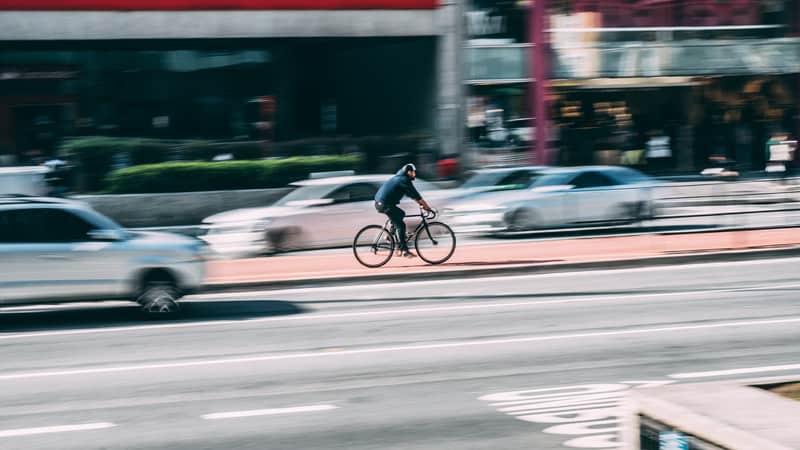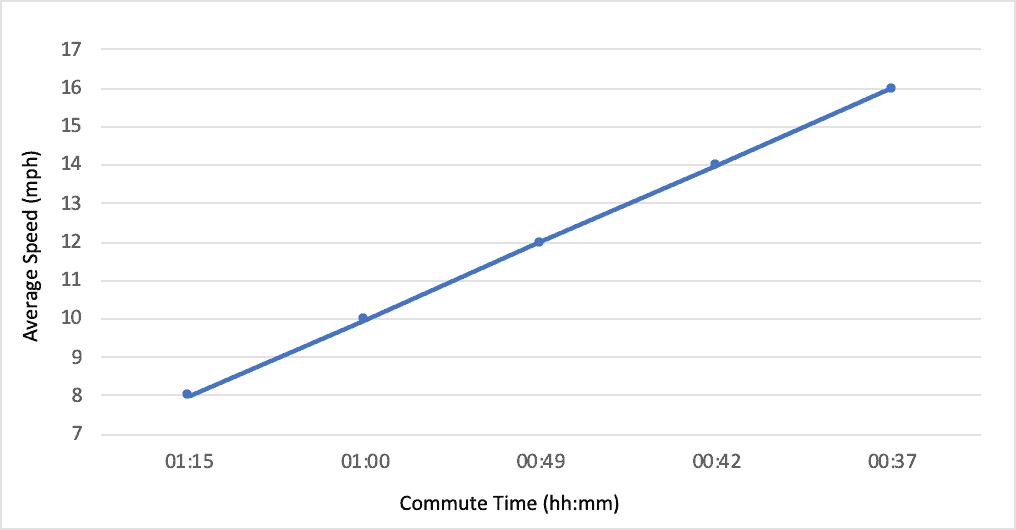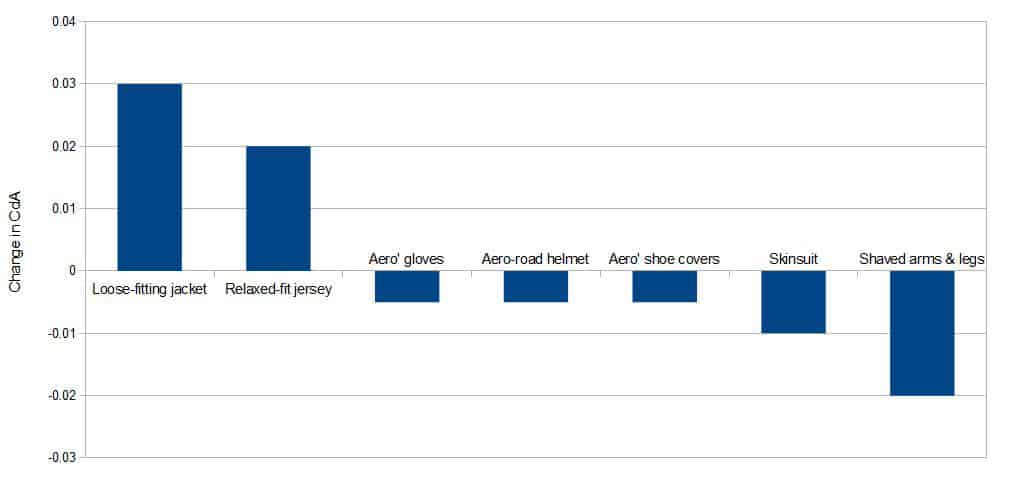
One question that is often asked by new bike commuters is what average speed can be achieved cycling to work. Let’s be honest, we usually want to get the commute out of the way as quickly as possible, we all want to spend more time in bed in the morning and want to get home as quickly as possible at the end of the day.
The average commuting bike speed is 12 mph (16 kph) and most cyclists can achieve this average speed very quickly and with limited training. After building some modest fitness and cycling experience, the average can be easily increased to 15 mph (24 kph).
Increasing your average speed will translate into a quicker commute when all other factors are considered. Although a number of factors influence total bike commuting time, your road speed is something you can positively influence.
Consider the simple table below to show how important average bike commuting speed can be for a 10-mile commute.
| Average Speed (mph) | Commute Time (hh: mm) |
| 8 | 01:15 |
| 10 | 01:00 |
| 12 | 00:49 |
| 14 | 00:42 |
| 16 | 00:37 |
When considering the average bike commute speed there are many factors to consider and there will be a number of influences specific for each individual. This can also vary from one day to the next due to external and internal factors. Optimising these factors can help you to maximise your average bike commute speed and consideration should be made into how small changes can result in an increased average speed.

Pick the Best Bike to Maximise Average Commute Speed
For road commuting, there is no doubt that you need a road bike if maximum speed is your objective. Road bikes are speed machines. The narrow wheels and thin profile tyres minimise rolling resistance meaning you can really get up to speed and maintain higher top speeds for longer. Coupled with the ultra-lightweight carbon fibre frames of most mid-range road bikes, road bikes are built for speed.
Carbon fibre lightweight road bikes can increase average speed by at least 5-10% and whilst this may seem minimal, many cyclist feel they are much quicker on a lightweight bike than other options. This may be a phycological placebo but…if a placebo works then it works. If nothing else, road bikes just don’t seem to battle you in the same way a mountain bike does.
Whilst this is a key factor, a few kilograms of weight saving on the bike can be negatively offset by carrying extra weight, either on yourself, or in a backpack whist packing your supplies for a day in the office, so it is worth packing as light as possible on the commute. There is a reason pro road bike racers are so lean!
Consider the Commuting Distance
The further you commute, the more difficult it will be to maintain a higher average speed. The increased distance means you will become fatigued which will impact the average speed you can maintain. Whilst this is normal, especially for someone with a low fitness level it should be considered and maximised where possible.
It is more optimal to ride at a steady, consistent pace that can be maintained, rather than going hell for leather in the early part of the commute and being unable to sustain it, you should target a level cadence that can be maintained throughout the commute.
Cadence on a bike is defined simply as the rate at which a cyclist pedals. Improving, and maintaining cadence will allow you longer and faster-peddling meaning average speed can be improved.
With optimal gear changes, you can maintain cadence over the length of your commute to make improvements on average speed. This article gives great cycling tips on improving cadence for the more serious rider. For the casual bike commuter, I wouldn’t get too hung up about it. Just look to maintain a steady and consistent pace over your commute distance.
Fitness Impact on Average Bike Commute Speed
Maintaining your average speed over the commute distance will come down to endurance and fitness. For low levels of fitness, the average speed will be reduced. The good news is that regular short rides are a great way to boost fitness, over a period of time, and improve cycling performance and taking it easier means you will be more likely to sustain a good bike commuting habit.
Fitness and weight loss are a lifestyle choice and many choose to use cycling to work as part of this overall healthy lifestyle balance. Cycling to work will not solve all the worlds obesity problems but it certainly can help if used in the right way with other training and a healthy, balanced diet.
To improve fitness, the body needs to be consistently challenged using progressive overload. In terms of cycling, this can mean riding for longer, riding faster or taking a more challenging route. This is where you can really use the opportunity for improving fitness on your commute by constantly challenging your average speed.
The best way to use your commute for fitness is just to get going. Start slow and build up, you will be thrashing the miles in no time!
Choosing the Optimal Route
Surface conditions can have an impact on your average speed. You will find off-road to be tougher going than a smooth road surface and this article has already considered the impacts of the choice of bike for these situations.
Your choice of route for your commute can have an impact on speed if you pick routes with hills to climb. Hill can seriously impact average speed in both a positive and negative way. Climbing will slow you significantly but going downhill can help to catch up and should average out over the course of a 10-mile average commute.
If your route is mostly climbing then over the whole commute at the start and the end of the day this should average out on your average speed.
If you want to optimise speed then pick a route with a smooth surface with the minimum amount of disruptions enabling you to maintain cadence and a consistent speed over the course of the commute.
Traffic Impact on Speed
When considering a city centre commute, or generally a traffic-heavy route, your commute time will be affected more by the traffic than your average speed. With this in mind, it could be worth trying alternative routes that minimise the impact of road traffic, pedestrian traffic and traffic lights and other general disruptions, even if that means your route is an increase in distance.
Traffic can turn a pleasant commute into a more difficult one. The traffic fumes alone can be unpleasant especially if you are stuck in standing traffic. A stop/start commute can also be challenging with your cadence and rhythm of cycling and getting back up to speed can also have a serious impact on your average speed.
The good news is, more and more city centres are heavily investing in dedicated cycle lanes which means you can bypass the issue of traffic and cycle to your destination less impeded. This also gives you the chance to maintain a higher average speed if you time traffic light changes effectively.
Off-road routes are not affected by the traffic issues of our road riding friends. Whilst it will be difficult, if not impossible, to match the road bike speeds off-road, the removal of traffic could enable a higher average speed depending on your current route and the under wheel conditions.
Air Resistance and Average Speed
In cycling, air resistance counts for 45-55% of a typical cyclist’s total resistance, in comparison weight only accounts for 24% of total resistance, so air resistance is by far the biggest contributor to impacting your average speed.
In a study performed by Ride Far, the key factor affecting air resistance is the rider’s body (75% contributor of total air resistance) and although things like accessories, bags and other items contribute, they are less significant. This resistance is affected by rider size, rider position and choice of clothing.
Changing your body shape and size is not something that can easily be accomplished, at least in the short term, and rider position can add discomfort to your commute that may be less than desirable. When considering a bike commute to work we need it to be a sustainable solution and forcing an uncomfortable riding position may just put the average commuter off.
Clothing is a simple improvement that can be made to help your average speed. The graph below shows the impact of different clothing types on aerodynamic drag.

As can be seen, some benefit can be gained by selecting cycling optimised clothing which will help to make a small improvement to your average commute speed.
As your speed increases, and you get more used to cycling then other areas, such as position, can be improved.
It is worth noting that these are marginal gains and will not shave significant time off your commute but it all helps.
Weather Impact on Average Speed
As air resistance provides a large contribution to overall average speed, a headwind can also have a significant impact. Through personal experience, riding in high winds can be challenging and significantly reduce the overall average speed.
Wind influences can be minimised by a general reduction in air resistance as described above but a strong wind is difficult to overcome. The key is to maintain cadence and as much momentum as possible in these conditions.
Other weather conditions have less impact on speed but can have an impact on phycology. Rain affects mood when cycling and is not pleasant as it can affect visibility. It can have some negative effects but speed isn’t one of them. It is important to take sharp bends more slowly due to a reduction in grip and recognise the impact on braking efficiency to ensure you remain safe.
Conclusions
As can be seen from this post, there are many factors which will affect the average bike speed for a commute and this can have an impact on the time taken to get to work, and more importantly, get home. Whilst being the quickest commuter is not that important, small savings can have a big impact over a long time bike commuting.
To maximise speed it is worth looking at reducing your load (carbon fibre bike frame, carry less, lose weight) and to reduce air resistance (choice of clothing, riding position). These small improvements will have a positive impact on your overall average speed.
